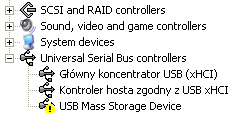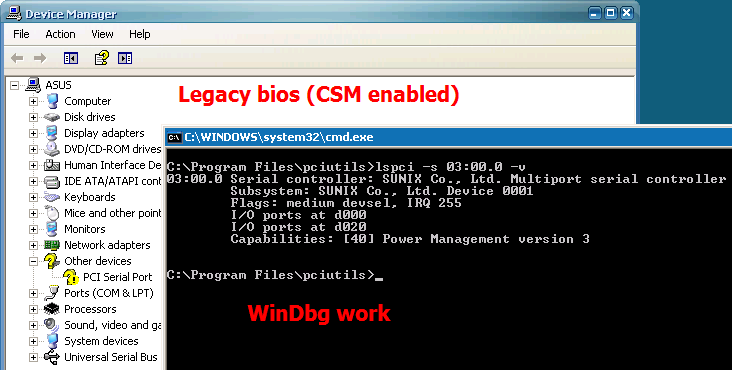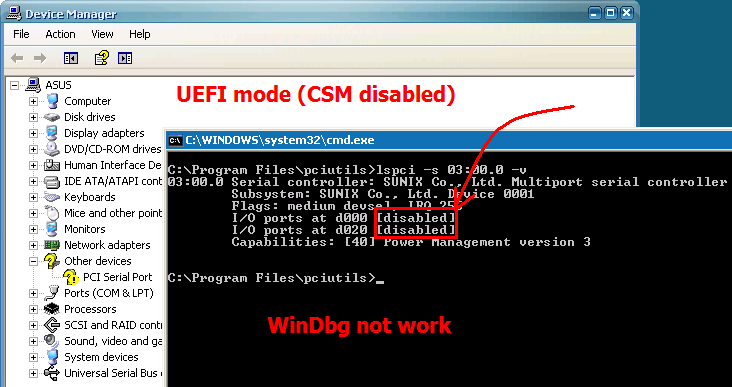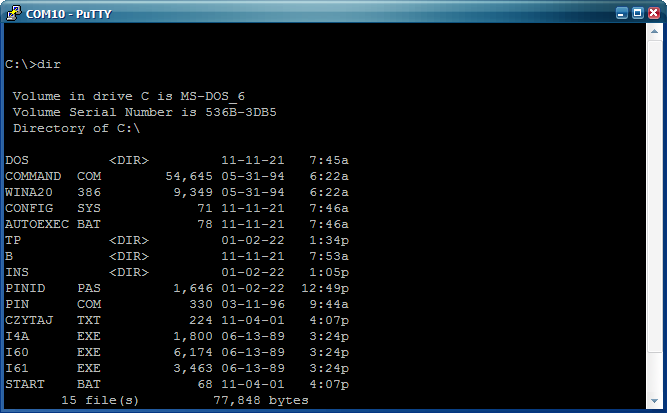-
XP/W2k3 x64 on Modern Hardware
@George King Do your ported drivers work with a clean WinXP SP2 64-bit? My tests show that: AHCI & NVMe > yes USB3 > no and Code 10 in device manager on xHCI controller, with ported acpi.sys xHCI OK but not work any USB device e.g. keyboard or USB stick and Code 39 in device manager: Someone wrote about USB3 and Code 39 error on mydigitallife.net but the topic is closed: I installed it on hardware, but the USB driver might be broken, no USB devices work even though the driver is recognized and installed.
-
I am looking for a PCIe card for WinXP debugging
@Dietmar Are you sure you are configuring the correct device for the bus:slot.func ??? In this post link you showed that all PCIe RS232 cards are under 02:00.0 and 03:00.0 is your SATA controller At 03:00.0 is my PCIe card!
-
I am looking for a PCIe card for WinXP debugging
@Dietmar I have good news. So far, I have tested the SER5427A card with WinDbg + modified kdcom.dll in legacy bios only. Today I decided to check under UEFI (CSM disabled) and it does not work. I noticed an important thing when the card driver is not installed in Windows. In UEFI mode, the lspci utility under WinXP shows that the I/O ports are disabled, while in legacy bios they are enabled: For WinDbg to run under UEFI, you need to enable ports under UEFI Shell and run WinXP without restarting from UEFI Shell: mm 03000004 1 -pci efi\boot\bootx64.efi Maybe your motherboards disable I/O ports in legacy bios mode? Check in WinXP with lspci that the I/O ports are enabled. If they are disabled, enable them in MS-DOS with the setpci utility and run WinXP with GRUB4DOS without restarting the computer: setpci -s xx:xx.x command=1 grub.exe
-
I am looking for a PCIe card for WinXP debugging
This is not crazy. If there are COM ports on the motherboard and they are enabled in the bios, sundos.exe detects these ports:
-
I am looking for a PCIe card for WinXP debugging
@infuscomus I am happy that with my RS232 cards - ExpressCard and PCIe works WinDbg for WinXP 32/64-bit 😀 I also checked KDNET for WinXP 32-bit and works and I am more interested in KDNET 64-bit: KDNET for WinXP/2003 64-bit FireWire and USB do not interest me.
-
I am looking for a PCIe card for WinXP debugging
@Dietmar How do you know the connection is lost?
-
I am looking for a PCIe card for WinXP debugging
@Dietmar What second boot? If you want to use the RS232 PCIe card under DOS you cannot restart the computer! The BIOS cannot configure the COM port on the PCIe card by itself. You have to do it manually by inserting the I/O address into memory, e.g. with debug -e 40:0 xx xx
-
I am looking for a PCIe card for WinXP debugging
@Dietmar Then it must be the motherboard's fault. It is definitely not the fault of WinXP or the SER5427A PCie card
-
I am looking for a PCIe card for WinXP debugging
@Dietmar Try without a driver, but it shouldn't matter - there will be an exclamation mark in device manager after debugging.
-
I am looking for a PCIe card for WinXP debugging
@Dietmar I have one more way with SER5427A: use original kdcom.dll (not modded) on debugged WinXP in boot.ini set baud 2400 COM1 in WinDbg set 19200 boot MS-DOS and run sundos.exe (D000 & COM1) - no restart PC, run GRUB4DOS (grub.exe) and boot WinXP
-
I am looking for a PCIe card for WinXP debugging
@Dietmar If the card works in DOS then it must also in WinDbg. You're making a mistake somewhere. I tested my card on two computers: desktop in PCIe x1 slot laptop+EXP GDC adapter ExpressCard-to-PCIe It works fine in both.
-
I am looking for a PCIe card for WinXP debugging
@Dietmar Is there communication with the second PC in MS-DOS if: boot MS-DOS and run sundos.exe set baudrate speed to 4800: mode com1:48,n,8,1,n on second PC, run Putty with a baudrate of 38400 on first PC execute the command: ctty com1 Do you have MS-DOS in Putty now? do e.g. dir or some other command
-
I am looking for a PCIe card for WinXP debugging
@Dietmar Very strange 🤔 Maybe because your WinXP SP3 has custom ACPI, USB, SATA drivers or modified ntldr, ntdetect.com etc. files ??? Try on a fresh installation of WinXP Pro SP3 32-bit VL and also on WinXP SP2 64-bit VL
-
I am looking for a PCIe card for WinXP debugging
@Dietmar I tested WinXP SP3 32-bit again and it works fine with the SER5427A card: if there is an integrated COM port on the motherboard, turn it off in MS-DOS 6.22 run the program SUNDOS.EXE and check base address and the port number on which the serial port is being installed - for me it is 4000 at COM1 set the base address (ABCD is little endian CDAB) in the kdcom.dll file in the offset responsible for the port number shown in sundos.exe if COM1 then offset C50, if COM2 then offset C47, if COM3 then offset C3E, if COM4 then offset C35 rebuild checksum edited kdcom.dll e.g. with CFF Explorer on debugged PC set in boot.ini debug to baudrate 14400 on port number shown in sundos.exe on PC with WinDbg running set baudrate 115200
-
I am looking for a PCIe card for WinXP debugging
@Dietmar The SER5427A card works 100% with WinDbg - read the topic carefully, everything is explained.
View in the app
A better way to browse. Learn more.
_14e30a.png)
_8126ce.png)






